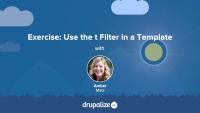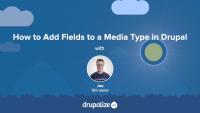DrupalCon Baltimore Tuesday, April 25th
Blog postDrupalCon Baltimore officially started yesterday, on April 24th with summits and workshops, and the arrival of thousands of Drupalers from around the world. The Drupalize.Me team delivered a hands-on workshop for Drupal 8 theming to a sold-out room, and kicked off the conference socializing at the official opening reception.
Today, Tuesday, April 25th is the first day of sessions, and it kicks off with the first keynote, by Dries Buytaert, also known as the Driesnote. The Driesnote is also always preceded by the Pre-note, for the early risers. After a full day of sessions and birds of a feathers, the Women in Drupal meetup will be happening at Luckie's Tavern from 6 to 8 p.m. tonight.
In this exercise, we'll practice using the t filter in a Twig template. As a best practice, all hard-coded text in a template should be translatable. Simple text (containing no dynamic tokens) can be passed through the t filter to achieve this objective. Along the way, we'll also use a basic conditional if statement with Twig. We recommend that you try following the exercise's steps first, and refer to the video if you need help.
How We Archived Outdated Tutorials
Blog postYou might have noticed some changes on Drupalize.Me lately. We’ve just wrapped up a huge content archiving project and I’d like to share what we did and how this will help us move forward with a library of tutorials for Drupal learners that we’re committed to keeping up-to-date.
Drupal media entities are fieldable entities, which means that you can add any custom fields you want to your Media types. These fields can be used for collecting additional metadata about a resource, categorizing and organizing resources so they're easier to find in a large media library, or for displaying information like a photo credit or transcript for a video. The possibilities are endless once you know how to add, and optionally display, fields in Drupal.
Some example use cases for adding fields to Media types:
- Collect, and display, a credit to go along with a photo. This could also be a date, a location, or any other metadata.
- Store resource width and height dimensions as custom fields so they can be referenced by display logic in the theme layer.
- Use Taxonomy reference fields to add tags or categories to help keep a large library organized.
In this tutorial we'll:
- Learn how to add fields to a Media type
- Verify our new custom field is working
By the end of this tutorial you'll know how to add custom fields to any Media type.
Drupalize.Me Update: March 2015
Blog postAs Drupal 8 approaches, our team has been growing and really pushing ourselves. Over the past few weeks, we released some impressive tutorials and site updates. Here's an overview.
This fall we’re trying something new: we’re offering real-time remote workshops. It’s not quite in-person, but I’m pretty excited to try it out.
Overview of development sites with an example deployment workflow for site building.
This guide was written, and is maintained, by Drupalize.Me. For more high quality written and video Drupal tutorials created by our team of experts, check out the collection of Drupalize.Me Guides.
We're sad to miss DrupalCon Europe in Amsterdam next week (October 28-31, 2019). But which talks would we attend if we were going? Amber and Joe combed through the program and created a list of what looks intriguing to us at the next DrupalCon. Will you be there? You might want to check out our picks.
We Get Around
We just finished our Do It With Drupal conference in Brooklyn, NY. If you missed the event, or were there and missed some of the sessions (there were so many good ones to see), we'll have videos of ALL the sessions on Drupalize.Me in a few weeks. You'll need to be a subscriber to access the videos, so if you're not already, sign up today.
Our 2016 Drupal 8 Tutorial Roadmap
Blog postMore and more people are getting excited about working with Drupal 8. We’ve been working full-speed to put together the most accurate Drupal 8 tutorials, as well as keeping them up to date, as Drupal 8 changes every 6 months. I wanted to give an update on where we are with our Drupal 8 material and give you a look at what to expect over the coming 3 months from our team.
PHP developers are pretty darn excited because Drupal 8 has a new object-oriented framework with some Symfony components. Are you ready to learn how to leverage these Symfony components in your Drupal 8 module? Then check out this new set of tutorials from our friends at KnpUniversity: Module Development Essentials.
New Tutorial Format Feedback
Blog postLast year we launched a new written format for our tutorials. We’re really excited about this format because it gives us the flexibility to present information in whatever way makes the most sense. With text and video on the same page, it's easy to find what you need, and it gives you the option to learn however you learn best.
Alter Drupal in Modules
GuideSettings Forms in Drupal
CourseWelcome to Our New Site
Blog postWe redesigned the site and upgraded to Drupal 7! A lot of the site and features remain the same, but we do have some changes we'd like to point out.
Drupal core comes with a few base themes: Stable, Stable 9, Classy, and Stark. Each one has a different intended use case. And all of them are useful as a reference for building your own themes.
In this tutorial we'll:
- Learn what each of the base themes included in Drupal core is intended to be used for
- Compare the output from the base themes with a focus on Stable and Classy
By the end of this tutorial you'll be able to explain the use case for each of the base themes included with Drupal core and make an informed decision about which, if any, to use when creating your own custom themes.
Every web framework, including Drupal, has basically the same job: provide a way for developers to map URLs to the code that builds the corresponding pages. Drupal uses Symfony's HTTPKernel component. Kernel events are dispatched to coordinate the following tasks:
- Process the incoming request
- Figure out what to put on the page
- Create a response
- Deliver that response to the user's browser
Knowing a bit more about how Drupal handles the request-to-response workflow will help you better understand how to use routes and controllers to create your own custom pages or deal with authentication, access checking, and error handling in a Drupal module.
In this tutorial we'll:
- Walk through the process that Drupal uses to convert an incoming request into HTML that a browser can read
- See how the Symfony
HTTPKernelhelps orchestrate this process - Learn about how the output from a custom controller gets incorporated into the final page
By the end of this tutorial, you should be able to describe the process that Drupal goes through to convert an incoming request for a URL into an HTML response displayed by the browser.
Release Day: Decoupled Drupal
Blog postToday we released a new series, Decoupled Drupal. This series walks through the basic considerations and planning that goes into deciding whether or not a decoupled approach is right for you.
The available dynamic tokens or variables vary from template to template. Each page is built from a set of templates.
In this exercise, we'll:
- Override and name the node template file so that it will only affect Article nodes on our Drupal site.
- Inspect the available variables.
- Customize the markup.
- Use the Twig filter
without.
We recommend that you try to work through the exercise yourself, and refer to the video if you need help.


